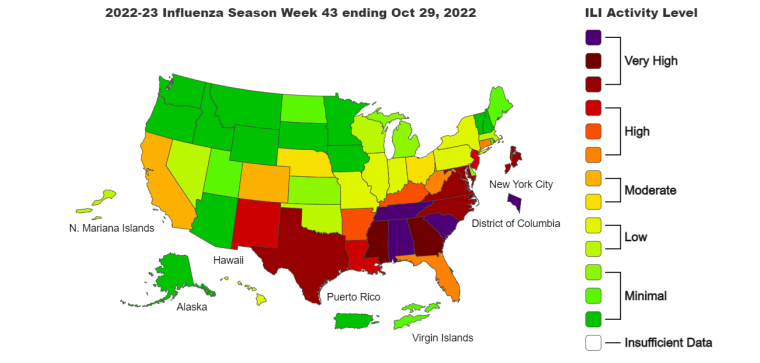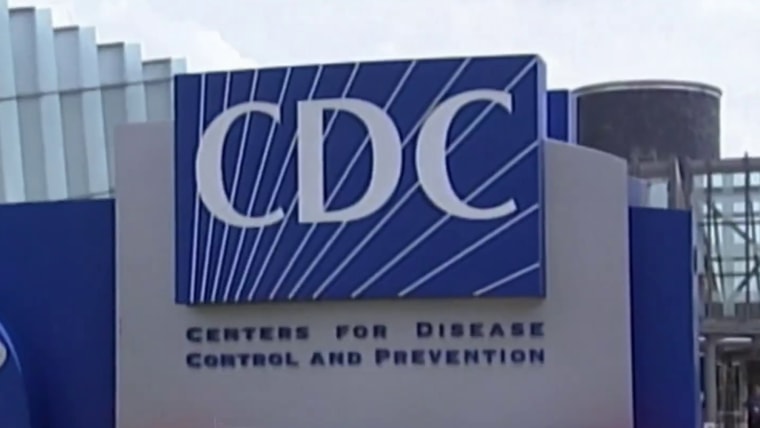The U.S. is seeing the highest flu hospitalization rates in a decade for this time of year, the Centers for Disease Control and Prevention said Friday, with people ages 65 and up hit the hardest, followed by young children.
The rise comes as other respiratory viruses, including respiratory syncytial virus, or RSV, are also spreading early and rapidly.
Common winter viruses tend to peak in December and January — not October and November — though it’s unclear how the early and intense spread of respiratory viruses will ultimately play out this season.
“Right now, we’re not seeing anything that would lead us to believe that it is more severe,” Lynnette Brammer, team lead of the domestic influenza surveillance team at the CDC, said of the flu during a media briefing Friday. “It’s just early right now.”
Still, Dawn O’Connell, assistant secretary for preparedness and response at the Department of Health and Human Services, warned that the U.S. will undoubtably “face some challenges this winter.”
It’s the first time since the beginning of the Covid pandemic that run-of-the-mill respiratory viruses are again circulating widely. Masks are off. Kids are back in school. People are congregating as they did pre-pandemic.
While lockdowns and masking were important to slow the spread of Covid earlier in the pandemic, they had a secondary impact: They also slowed the spread of other respiratory illnesses like the flu and RSV. Young children, as a result, didn’t encounter these viruses, leaving them with little to no immunity.
“We suspect that many children are being exposed to some respiratory viruses now for the first time, having avoided these viruses during the height of the pandemic,” Dr. José Romero, director of the CDC’s National Center for Immunization and Respiratory Diseases, said during Friday’s briefing.
Nationally, 76% of pediatric hospital beds are occupied, according to an NBC News analysis of HHS data. Twenty states are at 80% capacity or higher.
The CDC reported extremely high levels of flu-like illnesses in the Southeast, particularly in Alabama, South Carolina and Tennessee.
Another 13 states — Arkansas, Connecticut, Florida, Georgia, Kentucky, Louisiana, New Jersey, New Mexico, North Carolina, Mississippi, Texas, Virginia and West Virginia — also reported significant levels of spread.
The report only looks at “influenza-like” illnesses — with symptoms including a fever of at least 100 degrees Fahrenheit, cough and/or sore throat with any other known cause — as clinicians are not required to report each positive flu test to public health officials.
Other respiratory viruses, including rhinoviruses and enteroviruses, are also circulating widely, and could account for some of those illnesses.

The CDC estimated that, overall, there have been 1.6 million cases of the flu so far this season. Among those, 730 people have died.
That includes four children, according to state health departments: two in Texas, one in North Carolina and another in South Carolina.
RSV, another respiratory virus, is also spiking unseasonably early this year.
“We are seeing more cases of RSV than we have ever seen,” said Dr. Rachel Orscheln, a pediatric infectious diseases specialist at St. Louis Children’s Hospital in Missouri.
RSV is a common virus, and usually affects babies in their first year or two of life. While the vast majority of young children will only develop a minor cold, they are the ones most at risk for the worst outcomes. Babies who become sick enough to be admitted to the hospital often need help breathing. In some cases, they require mechanical ventilation.
Two children have reportedly died of RSV this season: a 6-year-old boy in Michigan and a baby in Virginia.
RSV typically hits Southeastern states hardest first, said Romero. That’s what happened so far this season, with the initial spike in the Southeast. RSV has eased up somewhat in those areas and is now spreading elsewhere across the country.
“We’ll probably start seeing cases rise on the West Coast in the coming weeks,” said Dr. Meredith McMorrow, a pediatrician and team lead for Enhanced Surveillance Platforms at the CDC.
Follow NBC HEALTH on Twitter & Facebook.
Source: | This article originally belongs to Nbcnews.com










